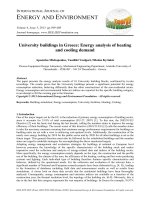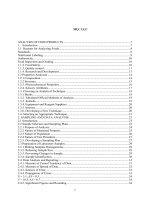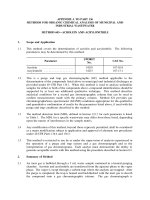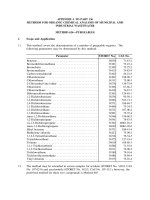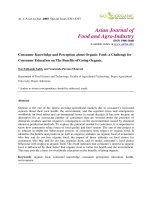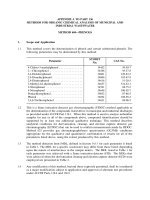Trace Element Analysis of Food and Diet pot
Bạn đang xem bản rút gọn của tài liệu. Xem và tải ngay bản đầy đủ của tài liệu tại đây (7.37 MB, 362 trang )
Trace Element Analysis of Food and Diet
RSC_TEAFD_Prelims.qxd 2/16/2006 8:35 PM Page i
RSC FOOD ANALYSIS MONOGRAPHS
Series Editor: P.S. Belton, School of Chemical Sciences, University of East Anglia, Norwich, UK
The aim of this series is to provide guidance and advice to the practising food analyst. It is
intended to be a series of day-to-day guides for the laboratory worker, rather than library
books for occasional reference. The series will form a comprehensive set of monographs pro-
viding the current state of the art on food analysis.
OTHER TITLES IN THIS SERIES:
Chromatography and Capillary Electrophoresis in Food Analysis
By H. Sorensen, S. Sorensen and C. Bjergegaard, Royal Veterinary and Agricultural
University Frederiksberg, Denmark and S. Michaelsen, Novo Nordisk A/S, Denmark
Dietary Fibre Analysis
By D.A.T. Southgate, Formerly of the AFRC Institute of Food Research, Norwich, UK
Mass Spectrometry of Natural Substances in Food
By F. Mellon, Institute of Food Research, Norwich, UK, R. Self, University of East Anglia,
Norwich, UK and J.R. Startin, Central Science Laboratory, York, UK
Quality in the Food Analysis Laboratory
By R. Wood, MAFF, Norwich, UK, H. Wallin, VTT Biotechnology and Food Research,
Finland, and A. Nilsson, National Food Administration, Sweden
The Maillard Reaction
By S.E. Fayle, Crop and Food Research, New Zealand and J.A. Gerrard, University of
Canterbury, New Zealand
Extraction of Organic Analytes from Foods: A Manual of Methods
By R. Self, University of East Anglia, Norwich, UK
How to obtain future titles on publication
A standing order plan is available for this series. A standing order will bring delivery of each
new volume upon publication. For further information please contact:
Sales and Customer Care
Royal Society of Chemistry, Thomas Graham House
Science Park, Milton Road, Cambridge, CB4 0WF, UK
Telephone: +44(0)-1223-420066, Fax: +44(0)-1223-426017,
Email:
RSC_TEAFD_Prelims.qxd 2/16/2006 8:35 PM Page ii
Trace Element Analysis of
Food and Diet
Nam
k K. Aras
Middle East Technical University, Retired
Turkish Academy of Sciences, Member
Ankara, Turkey
O. Yavuz Ataman
Middle East Technical University
Ankara, Turkey
RSC_TEAFD_Prelims.qxd 2/16/2006 8:35 PM Page iii
Cover image based on an image courtesy of USDA-ARS
ISBN-10: 0-85404-576-7
ISBN-13: 978-085404-576-1
A catalogue record for this book is available from the British Library
© The Royal Society of Chemistry 2006
All rights reserved
Apart from fair dealing for the purposes of research for non-commercial purposes or for pri-
vate study, criticism or review, as permitted under the Copyright, Designs and Patents Act
1988 and the Copyright and Related Rights Regulations 2003, this publication may not be
reproduced, stored or transmitted, in any form or by any means, without the prior permission
in writing of The Royal Society of Chemistry, or in the case of reproduction in accordance
with the terms of licences issued by the Copyright Licensing Agency in the UK, or in accor-
dance with the terms of the licences issued by the appropriate Reproduction Rights
Organization outside the UK. Enquiries concerning reproduction outside the terms stated
here should be sent to The Royal Society of Chemistry at the address printed on this page.
Published by The Royal Society of Chemistry,
Thomas Graham House, Science Park, Milton Road,
Cambridge CB4 0WF, UK
Registered Charity Number 207890
For further information see our web site at www.rsc.org
Typeset by Macmillan India Ltd, Bangalore, India
Printed by Henry Ling Ltd, Dorchester, Dorset, UK
RSC_TEAFD_Prelims.qxd 2/16/2006 8:35 PM Page iv
Preface
The researchers who choose to work in the field of trace element determinations are
not necessarily experienced analytical chemists. However, once involved in this sort
of research, they either should acquire the necessary instrumentation in their labora-
tory or should be able to communicate with their collaborating colleagues who will
probably be analytical chemists. In any case, this type of reader will need to know
more about analytical chemistry, its language, literature and basics. Some chapters
of this book will address this class of reader who need a rather quick review of the
field through easy reading.
The book should also be useful to readers who perform actual experiments for
sampling, analysis and evaluation. Therefore, especially the last chapter will provide
the reader with procedures, brief suggestions for methodology and current refer-
ences. All chapters include illustrations. These are mostly adapted from original arti-
cles or literature developed by manufacturing companies. Therefore, our choice of
this particular approach is intended to establish some useful linkages between the-
ory and actual practices in the manufacturing world.
The language, style and appearance of the book have been designed carefully by
the authors who both have over thirty years of teaching and research experience in
the field of analytical chemistry that hopefully has contributed to the pedagogical
aspect of the book. This book is expected to provide an easily comprehensible basic
orientation for those new in the field while at the same time offering ample oppor-
tunities for experienced researches to acquire new perspectives.
Some parts of Chapter 9, Nuclear Activation Analysis, have been based on the lec-
ture notes of N.K. Aras and D.L. Anderson, which were prepared while they were
giving a short course at the University of Maryland. Namk Aras would like to thank
to late Professor Glen E. Gordon who taught him the importance of trace elements
during his years at MIT and University of Maryland and to Robert Parr from IAEA
for many years of fruitful discussions on trace elements in diet. Thanks are also due
to R. Lindstrom from NIST and M. Yukawa from National Institute of Radiological
Sciences, Japan for providing gamma ray and PIXE spectra of diet samples, and
Özge Hacfazlog˘lu for helping us in organizing the index of this book. Special
thanks go to Peter Belton who encouraged us to write this book; and Annie Jacob,
Janet Freshwater and Katrina Turner from the RSC for their organizational help.
Finally we thank our wives Çig˘dem Aras and Gülay Ataman for their moral support
and patience throughout this endeavor.
Namk K. Aras and O. Yavuz Ataman
January, 2006
RSC_TEAFD_Preface.qxd 2/16/2006 9:39 PM Page v
RSC_TEAFD_Preface.qxd 2/16/2006 9:39 PM Page vi
Contents
Abbreviations xv
Chapter 1 Introduction 1
1.1 Importance of Trace Elements in Food 1
1.1.1 Essential Trace Elements 1
1.1.2 Classification of Trace Elements 3
1.1.3 Discovery of Essential Trace Elements 3
1.1.4 Functions of Trace Elements 5
1.2 Trace Element Studies 5
References 6
Chapter 2 Statistical Evaluation of Data 8
2.1 Introduction 8
2.2 Analytical Errors 8
2.2.1 Accuracy and Precision 8
2.2.2 Determinate and Indeterminate Errors 9
2.2.3 Significant Figures 9
2.3 Mean, Median, Mode, Range and Mean Deviation 10
2.3.1 Mean 11
2.3.2 Median 11
2.3.3 Mode 11
2.3.4 Range 11
2.3.5 Mean Deviation 11
2.4 Normal Distribution of Random Variables:
Gaussian Distribution 12
2.4.1 Log-Normal Distribution 13
2.4.2 Standard Deviation 14
2.5 Confidence Limit, Confidence Interval and
Confidence Level 15
2.6 Student’s t Distribution: Confidence Limit for
Small Number of Measurements 16
2.7 Testing for Statistical Hypothesis 17
2.7.1 Comparison of Experimental Means with
True Value or with Each Other: Student’s
t Test 17
RSC_TEAFD_Contents.qxd 2/6/2006 4:35 PM Page vii
2.7.2 Comparison of Two Experimental Standard
Deviations: The F Test 18
2.8 Rejection of Outliers 19
2.8.1 Dixon’s Q Criterion 19
2.8.2 Student’s t Criterion 19
2.8.3 Gibbs’s R Criterion 19
2.9 Linear Regression Analysis 22
2.9.1 Multiple Linear Regression 25
2.10 Receptor Models 26
2.10.1 Factor Analysis 27
2.10.2 Chemical Mass Balance Method 29
2.10.3 Enrichment Factors of the Elements 30
References 30
Chapter 3 Trace Analysis 32
3.1 Scope of Trace Analysis 32
3.2 Methodology, Terms and Definitions 33
3.2.1 Sample, Analyte, Matrix and Blank 33
3.2.2 Qualifications for a Trace Analysis Laboratory 33
3.2.2.1 Water Purification 35
3.2.3 Precision, Accuracy and Traceability 39
3.2.4 Calibration 40
3.2.5 Analytical Figures of Merit 41
3.2.5.1 Detection Limit and Limit of
Quantitation 41
3.2.5.2 Analytical Range 42
3.2.5.3 Sensitivity 43
3.2.5.4 Signal to Noise Ratio 44
3.2.5.5 Relations between Precision,
Sensitivity, DL and S/N 44
3.2.6 Selectivity and Interference 45
3.2.7 Legal Importance of Results,
Traceability and Other Related Concepts 49
References 51
Further Reading 52
Chapter 4 Sampling and Sample Pre-treatment 53
4.1 General Guidelines in Collection and
Preparation of Staple Foods and Diets 53
4.2 Sampling of Major Staple Foods 54
4.2.1 Wheat 54
4.2.2 Wheat Flour 55
4.2.3 Bread 55
viii Contents
RSC_TEAFD_Contents.qxd 2/6/2006 4:35 PM Page viii
4.2.4 Pasta 56
4.2.5 Rice 56
4.2.6 Potato 56
4.2.7 Meat 57
4.2.8 Vegetables and Fruits 58
4.2.9 Milk 58
4.2.10 Fresh Eggs 59
4.2.11 Other Staple Foods 59
4.3 Collection of Diet Samples 59
4.3.1 Collection and Preparation of Foods for
Composition of Representative Mixed
Total Daily Diets, Market Basket Method 60
4.3.2 Collection of Food Samples 62
4.3.3 Duplicate Portion Technique 62
4.3.4 Homogenization and Freeze Drying 62
4.4 Sample Dissolution and Decomposition 63
4.4.1 Dry Ashing Techniques 66
4.4.2 Wet Ashing Techniques 66
4.4.2.1 Open Wet Digestion 69
4.4.2.2 Closed Wet Digestion 70
References 73
Further Reading 74
Chapter 5 Spectrochemistry for Trace Analysis 75
5.1 Fundamentals, Definitions and Terms 75
5.2 Atomic and Molecular Spectrometry 84
5.2.1 Molecular Spectrometry 85
5.2.2 Luminescence Spectrometry 86
5.2.3 Atomic Spectrometry 86
5.3 Instrumentation 86
5.3.1 Basic Components for Spectrometric
Instrumentation 87
5.3.1.1 Some Important Optical Units 87
5.3.1.2 Wavelength Selectors 89
5.3.1.3 Sources 98
5.3.1.4 Detectors 101
Further Reading 104
Chapter 6 Atomic Absorption Spectrometry 105
6.1 Introduction, History and Principles 105
6.2 Instrumentation 107
6.2.1 Sources 107
6.2.2 Monochromators 109
Contents ix
RSC_TEAFD_Contents.qxd 2/6/2006 4:35 PM Page ix
6.2.3 Atomizers 109
6.2.3.1 Flame Atomizers 109
6.2.3.2 Furnace Atomizers 111
6.2.3.3 Cold Vapour Atomic Absorption
Spectrometry (CVAAS) 116
6.2.3.4 Hydride Generation Atomic
Absorption Spectrometry 117
6.2.3.5 Atom Traps for Flame Atomizers 118
6.3 Interferences 119
6.3.1 Non-spectral Interferences 120
6.3.2 Spectral Interferences 122
6.4 Analysis of Solid Samples 130
6.5 A General Evaluation and Capabilities of
AAS Systems 131
References 134
Further Reading 135
Chapter 7 Atomic Emission and Mass Spectrometry using
Plasma Techniques 136
7.1 Introduction, History and Principles 136
7.2 Optical Emission Spectrometry 138
7.2.1 Optical Emission Spectrometry with
Classical Sources 138
7.2.2 Optical Emission Spectrometry with
Plasma Sources 140
7.2.2.1 Power Supplies for RF Generation 142
7.2.2.2 Sample Introduction Systems 143
7.2.2.3 Detection Systems and Measurement
Modes in ICP-OES 146
7.2.2.4 Interferences 148
7.3 Inductively Coupled Plasma–Mass Spectrometry 150
7.3.1 Instrumentation 152
7.3.1.1 Mass Analyzers 152
7.3.1.2 Detectors 154
7.3.2 Interferences 155
7.3.2.1 Spectral Interferences 155
7.3.2.2 Non-spectral Interferences 157
7.3.2.3 Approaches for Elimination of
Interferences 158
7.3.3 Isotope Dilution ICP-MS 160
7.3.4 Instruments and Applications 162
References 163
Further Readings 163
x Contents
RSC_TEAFD_Contents.qxd 2/6/2006 4:35 PM Page x
Chapter 8 Atomic Fluorescence Spectrometry 164
8.1 Introduction, History and Principles 164
8.2 Instrumentation 167
8.2.1 Excitation Sources 168
8.2.2 Atomizers 168
8.3 Interferences 170
8.4 Instrumentation and Applications 170
References 171
Further Reading 171
Chapter 9 Nuclear Activation Analysis 172
9.1 Introduction 172
9.2 Basic Principles 172
9.2.1 Radioactive Decay 173
9.2.2 Half-Life 173
9.2.3 Irradiation with Neutrons and
Charged Particles 174
9.3 Neutron Activation Analysis 176
9.3.1 Cross Section 177
9.3.2 Neutron Sources 177
9.3.2.1 Laboratory Neutron Sources 177
9.3.2.2 Research Reactors 178
9.3.3 Preparation of Samples for Irradiation 178
9.3.4 Short Irradiation 179
9.3.5 Intermediate and Long-Lived Isotopes,
Long Irradiation 180
9.3.6 Calculation of Activity Produced after
Neutron Irradiation 181
9.3.7 Measurement of Gamma Rays 184
9.3.7.1 Interaction of Gamma Rays with
Matter 184
9.4 Other Nuclear Techniques 188
9.5 Determination of Trace Elements in Total Diet by
Neutron Activation Analysis 189
9.6 Present Status of Activation Analysis by
Comparison with Other Analytical Techniques 189
References 191
Chapter 10 X-Ray Methods 192
10.1 Introduction 192
10.2 Basic Principles 193
10.3 X-Ray Fluorescence Spectrometry 194
10.3.1 Production of X-Rays 195
Contents xi
RSC_TEAFD_Contents.qxd 2/6/2006 4:35 PM Page xi
10.3.2 Wavelength Dispersive X-Ray
Fluorescence Spectrometry 197
10.3.3 Energy Dispersive X-Ray Fluorescence 198
10.3.4 Total Reflection X-Ray Fluorescence
Spectrometry 199
10.4 Particle-Induced X-Ray Emission Spectrometry 201
10.5 Quantitative Determination in XRF Methods 202
References 204
Chapter 11 Speciation Analysis 205
11.1 Importance of Speciation Analysis and
Related Terms 205
11.2 Chromatography and Electrophoresis 207
11.2.1 Common Laws and Properties for
Chromatography and Electrophoresis 211
11.2.2 Instruments for Chromatography and
Electrophoresis 215
11.2.2.1 Columns 215
11.2.2.2 Detectors 216
11.3 Typical Instruments 219
References 221
Further Reading 221
Chapter 12 Comparison of Analytical Techniques 222
12.1 General Approaches for Selecting a Technique 222
12.2 Criteria for Selecting an Analytical Technique 222
12.2.1 Considerations for Sample Preparation 223
12.2.2 Sensitivity 224
12.2.3 Speed 225
12.2.4 Ease of Use 226
12.2.5 Cost of Instrumentation and Analysis 228
12.3 Evaluation of Individual Analytical Techniques 232
Chapter 13 Essentiality and Toxicity of Some Trace Elements
and Their Determination 233
13.1 Introduction 233
13.2 Essential and Probably Essential
Trace Elements 233
13.2.1 Boron 233
13.2.2 Chromium 237
13.2.3 Cobalt 237
13.2.4 Copper 238
xii Contents
RSC_TEAFD_Contents.qxd 2/6/2006 4:35 PM Page xii
13.2.5 Iodine 239
13.2.6 Iron 239
13.2.7 Manganese 240
13.2.8 Molybdenum 240
13.2.9 Nickel 241
13.2.10 Selenium 242
13.2.11 Silicon 244
13.2.12 Tin 245
13.2.13 Vanadium 245
13.2.14 Zinc 246
13.3 Potentially Toxic Elements: Some Possibly
with Essential Function 248
13.3.1 Arsenic 248
13.3.2 Fluorine 249
13.3.3 Cadmium 250
13.3.4 Lead 252
13.2.5 Mercury 252
13.3.6 Aluminium 253
13.4 Literature on Determination of Trace
Elements in Food Samples 254
References 304
Subject Index 336
Contents xiii
RSC_TEAFD_Contents.qxd 2/6/2006 4:35 PM Page xiii
RSC_TEAFD_Contents.qxd 2/6/2006 4:35 PM Page xiv
Abbreviations
AAS Atomic absorption spectrometry
AES Atomic emission spectrometry
AFS Atomic fluorescence spectrometry
AgDDC Silver diethyldithiocarbamate
AOAC Association of Official Analytical Chemists
APDC Ammonium pyrrolidine dithiocarbamate
AsB Arsenobetaine
CCD Charge coupled device
CE Capillary electrophoresis
CEC Capillar electrochromatography
CID Charge injection device
CM Chemical modifier
CRM Certified reference material
CTD Charge transfer device
CV-ICP-MS Cold vapour inductively coupled plasma mass spectrometry
DAN Diaminonaphtalene
DBT Di-butyl tin
DCP Direct current plasma
DDTC Diethydithiocarbamate
DL Detection limit
DMA Dimethylarsinate
ECD Electron capture detector
EDXRF Energy dispersive X-ray fluorescence
EG Electrochemical generation
EIE Easily ionizable elements
ES Electrospray
ETAAS Electrothermal atomic absorption spectrometry
ETV Electrothermal vaporizer
FAAS Flame atomic absorption spectrometry
FAES Flame atomic emission spectrometry
FAFS Flame atomic fluorescence spectrometry
FI Flow injection
FID Flame ionization detector
FT Fourier transform
FWHM Full width at half maximum
RSC_TEAFD_Abbre.qxd 2/22/2006 2:36 PM Page xv
GC Gas chromatography
GC-AES Gas chromatography-atomic emission spectrometry
GD Glow discharge
GFAAS Graphite furnace atomic absorption spectrometry
GLC Gas liquid chromatography
HEPA High efficiency particulate air
HG Hydride generation
HGAAS Hydride generation atomic absorption spectrometry
HG-AFS Hydride generation atomic fluorescence spectrometry
HG-ICP-MS Hydride generation Inductively coupled plasma
mass spectrometry
HG-ICP-OES Hydride generation Inductively coupled plasma optical
emission spectrometry
HPLC High pressure liquid chromatography
IBMK Isobutylmethylketone
IC Ion chromatography
ICP Inductively coupled plasma
ICP-MS Inductively coupled plasma mass spectrometry
ICP-OES Inductively coupled plasma optical emission spectrometry
ICR-MS Ion cyclotron resonance mass spectrometry
ID Isotope dilution
IEC Ion exchange chromatography
IFNAA Instrumental fast neutron activation analysis
INAA Instrumental neutron activation analysis
IR Infrared
ISE Ion selective electrode
IUPAC International Union of Pure and Applied Chemistry
LA Laser ablation
LC Liquid chromatography
LEAF Laser excited atomic fluorescence
LOD Limit of detection
LOQ Limit of quantitation
MAA Molecular activation analysis
MALDI Matrix assisted laser desorption ionization
MIBK Methylisobutylketone
MIP Microwave induced plasma
MIP-AES Microwave induced plasma - atomic emission spectrometry
MM Matrix modifier
MMA Monomethylarsonate
MS Mass spectrometry
MW Microwave
MWD Microwave digestion
NAA Neutron activation analysis
NIST National Institute of Standards and Technology
OES Optical emission spectrometry
PDA Photodiode array
xvi Abbreviations
RSC_TEAFD_Abbre.qxd 2/22/2006 2:36 PM Page xvi
PFA Perfluoroalkoxyfluorocarbon
PGAA Prompt gamma activation analysis
PIXE Particle induced X-ray emission
PTFE Polytetrafluoroethylene
Q Quadrupole
QA Quality assurance
QC Quality control
QMA Quadrupole mass analyzer
REE Rare earth elements
RF Radio frequency
RSD Relative standard deviation
S/N Signal to noise ratio
SDS-PAGE Sodium dodecylsulfate polyacrylamide gel electrophoresis
SEC Size exclusion chromatography
SFC Supercritical fluid chromatography
SP Spectrophotometry
SPME Solid phase micro extraction
SR Synchroton radiation
SRM Standard reference material
SRXRF Synchroton radiation X-ray fluorescence
SSMS Spark source mass spectrometry
SXRF Synchroton X-ray fluorescence
TBT Tributyl tin
TCA Trichloroacetic acid
TCD Thermal conductivity detector
THF Tetrahydrofuran
THGA Transversely heated graphite atomizer
TIMS Thermal ionization mass spectrometry
TMAH Trimetylammonium hydroxide
TOF Time of flight
TOF-MS Time of flight mass spectrometry
TXRF Total reflection XRF
USN Ultrasonic nebulisation
UV Ultraviolet
VIS Visible
WDXRF Wavelength dispersive X-ray fluorescence
XRF X-ray fluorescence
Abbreviations xvii
RSC_TEAFD_Abbre.qxd 2/22/2006 2:36 PM Page xvii
RSC_TEAFD_Abbre.qxd 2/22/2006 2:36 PM Page xviii
CHAPTER 1
Introduction
1.1 Importance of Trace Elements in Food
1.1.1 Essential Trace Elements
Food and beverages ingested by humans represent a potentially proficient pathway
of exposure to toxic and nutritionally important minor and trace elements. Many
mineral elements occur in living tissues, food and diets in such small amounts that
they are frequently described as “traces” and the phrase “trace elements” arose to
describe them. At the present time, less than one-third of the 90 naturally occurring
elements are known to be essential for life.
The bulk of human body is composed of six major elements; oxygen, carbon,
hydrogen, nitrogen, calcium and phosphorus and six minor elements; sulfur, potas-
sium, sodium, chlorine, magnesium and silicon. The total percentage of minor and
major elements in total body weight is 98.8 (Table 1.1).
1
If six noble gases are
excluded as unlikely to have a physiological function, 71 elements of the periodic
system remain, and because of their low concentration in living matter, are termed
the “trace elements”.
The concentration of major and minor elements in living tissues can be expressed
in grams per kilogram. On the other hand, the concentration of trace elements in liv-
ing tissues varies between 0.01 and 100 mg kg
−1
(Table 1.2). It may not be appropri-
ate to classify them as essential or toxic elements. It is logically wrong to establish a
category of “toxic” elements, because any element may be potentially toxic and this
property is but a function of concentrations to which humans are exposed.
Essentiality of the trace elements is established when a further reduction below the
range of tolerable levels, better known as “range of safe and adequate intakes”, results
in a consistent and reproducible impairment of a physiological function.
2,3
These considerations suggest a logical classification of the 71 trace elements into
those, with proven essentiality and the rest for which essentiality is “presently not
known”. This classification leaves room for the possibility that future research will
include additional elements as essential. Each of the two categories can be subdi-
vided according to their practical importance under given conditions; e.g., local,
regional or national imbalance in the environment, industrial emissions or dietary
habits. Some essential elements may not be of any nutritional concern at all, as in
RSC_TEAFD_ch001.qxd 2/16/2006 7:25 PM Page 1
2 Chapter 1
the case of magnesium in human nutrition, since it is in sufficiently high levels; oth-
ers, such as selenium, may have the highest regional importance because of defi-
ciency in one area and toxicity in another.
In recent years, there has been an increase in the realization of the importance of
the role of trace elements in biological systems. The study of life processes shows
that many vital functions are dependent on the presence of a specific trace element.
Because of that, trace elements are one of the important nutrient factors for the
growth and maintenance of human and animal life.
Food only, excluding intakes from water and air, normally supplies a major pro-
portion of the total daily trace element intake by humans. Since the late 1950s, con-
cerns over the introduction of trace elements and many other components into the
environment as a result of human activities have greatly increased. Besides soil and
water, food is also contaminated with trace metals by the introduction of mecha-
nized farming, ever increasing use of chemicals, sprays, preservatives, food pro-
cessing and canning. In order to get the minimum adverse impact, it is important to
measure and continuously monitor their levels in various food items, total diet,
water and inhaled air.
The concentrations of trace elements in food give important information about
dietary habits of special group, health situation of individuals and origins of ele-
ments. Therefore, it is important to determine the daily dietary intake of trace ele-
ments, their concentrations and sources.
Recent developments of trace element research in the area of nutrition have led to
a need to accurately and precisely determine the content of these micronutrients in
food. In the past several decades, the analytical chemistry community has made
great advances in improvement in sensitivity, selectivity and accuracy of analytical
methodology.
Table 1.1 Concentrations of major and minor elements in reference
man (percent in total body weight)
Major elements Percent (%) Minor elements Percent (%)
O 61 S 0.2
C 23 K 0.2
H 10 Na 1.4
N 2.6 Cl 1.2
Ca 1.4 Mg 0.03
P 1.1 Si 0.03
Table 1.2 Range of concentrations of
trace elements in human body
Element mg kg
−
1
Fe, F, Zn 100.0
Rb, Sr, Cu, Pb, Br 10.0
Sn, Sc, Cd, Mn, Ba, Al 1.0
Cs, Co, Cr, Mo, Au, Ni 0.1
RSC_TEAFD_ch001.qxd 2/16/2006 7:25 PM Page 2
In this book, we will present experimental techniques for the collection, prepara-
tion and determination of trace elements in food. All the modern techniques will be
discussed in some detail so that it will be useful for both researcher and technical
staff who are working in this area.
1.1.2 Classification of Trace Elements
The simplest definition of trace essential element is that it is required in small
amount for the maintenance of life; its absence results in death or a severe malfunc-
tion of the organism.
All major and minor elements are important; besides that, some of the trace ele-
ments e.g; Cr, Fe, Co, Cu, Zn, Se, Mo and I are essential trace elements; and some of
them; Mn, Si, Ni, B, V, and Sn are probably essential trace elements; and further some
of them F, As, Cd, Pb, Al and Hg are considered potentially toxic, some possibly essen-
tial elements for animal and human life. Actually all essential elements may also be
toxic in animals and humans if ingested at sufficiently high levels and for a long
enough period (Fig.1.1)
4
. The above elements will be discussed in detail in Chapter 13.
Essential trace elements are required by man in amounts ranging from 50 µg day
Ϫ1
to 20 mg day
−1
. The organism can neither grow nor complete its life cycle without
the element in question. The element should have a direct influence on the organism
and be involved in its metabolism. The effect of the essential element cannot be
wholly replaced by any other element.
The bioavailibilities of the essential elements depend on their chemical form, the
compositions of diet and health situation of the individuals. Thus, establishment of
the optimum daily requirements and determination of actual daily intake of essential
elements are important problems of trace element in nutrition.
5
The essential trace elements provide a classical example of required nutrients as
described by Bertnard as early as 1911. An organism may go through several stages
as the concentration of essential nutrient progresses from deficiency to excess. In
absolute deficiency, death may result, with limited intake; the organism survives but
may show marginal insufficiency. With increasing nutrient, a plateau representing
the optimal function is reached. As the nutrient is given in excess, first marginal tox-
icity then mortal toxicity are attained while this curve may vary quantitatively for
each essential nutrient, the basic pattern holds for virtually all the essential trace ele-
ments. This is illustrated in Figure 1.2 for selenium. There is barely a fourfold range
between intake per day for survival and that for the appearance of toxic effects.
5
1.1.3 Discovery of Essential Trace Elements
The study of the discovery of essential trace elements has been outlined by Schrauzer.
6
The treatment of anaemia with iron and the association of iodine deficiency with goiter
marked these as the only two essential trace elements recognized for animals before the
twentieth century. In the twentieth century, there were two major periods of activity in
biological trace element research. In the early classical period, 1925–1956, the essen-
tiality of copper, zinc, cobalt, manganese and molybdenum in animals was discovered.
A more active modern period, 1957–1980, dominated by the late Klav Schwarz, was
Introduction 3
RSC_TEAFD_ch001.qxd 2/16/2006 7:25 PM Page 3
4 Chapter 1
H
He
BeLi
B
C
N
O
F
Ne
Na
Mg
Al Si P S Cl
Ar
K
Ca
Sc Ti V Cr Mn Fe Co Ni Cu Zn Ga Ge As
eSrBrK
Rb Sr
YZrNbMoTcRuRhPdAgCdInSnSbTe IXe
sCBa
La Hf Ta W Re Os Ir Pt uAgHlTbPiBoPtAnR
Fr Ra
s
t
n
e
me
l
EkluB
l
a
i
t
nessE
st
ne
me
lE
eca
rT
l
aitn
es
sE
s
t
n
e
melEec
a
rTlaitnessEylb
a
borP
stnemelE
e
carT
l
a
i
tn
e
s
sEs
Ayl
b
i
s
so
P
emoS,cixoT
y
l
l
a
i
t
n
e
toP
Figure 1.1 Present status of the essentiality of the elements in the periodic table. The 12 bulk elements and 18 trace elements are identified as essential
RSC_TEAFD_ch001.qxd 2/16/2006 7:25 PM Page 4
marked by the experimental induction of trace element deficiencies. These efforts have
resulted in evidence supporting the essentiality of selenium, chromium, tin, vanadium,
fluorine, silicon, nickel, lead, cadmium, arsenic and most recently lithium.
1.1.4 Functions of Trace Elements
Most of the trace elements serve a variety of functions, depending upon their chem-
ical form or combination and their location in the body tissues and fluids.
Minor and trace elements serve in two general roles. The first one is their function
as structural material. Iron is part of the structure of the oxygen-carrying protein,
haemoglobin, in the red blood cells; calcium, phosphorus and other elements con-
stitute a significant part of the mass of teeth and bones; and sodium, potassium,
phosphate, sulfate, chloride and many other elements are important constituents of
the fluids, both inside and outside all the body cells.
The second general role of trace elements is their function in regulating numerous
biological activities. Calcium in minute concentrations is necessary for normal blood
clotting; magnesium stimulates the activity of many enzymes and a number of trace
elements control the contraction of muscle and the transmission of impulses by
nerve cells. Table 1.3 lists the macrominerals and trace elements known to be essen-
tial in human nutrition and their functions.
5,6
1.2 Trace Element Studies
The study of trace element contents in food, environmental and biological samples
has attracted worldwide interest, and a lot of papers are published in this field. Since
early 1970s, there has been an increasing interest in the levels of several elements in
composite diet and individual food items such as honey, meat, milk, wheat, water,
Introduction 5
Figure 1.2 Dose–response range of an essential element. Estimates of specific requirements
in terms of micrograms per day for selenium
RSC_TEAFD_ch001.qxd 2/16/2006 7:25 PM Page 5
fish and vegetables.
7,8
Also a great deal of research has been undertaken on the con-
centration of essential trace elements in biological materials such as fluids and tis-
sues. Attempts have been made in recent years to understand the role of trace
elements in biological system, particularly in human metabolism.
The results obtained by the analyses of the trace elements in foods may not show
the exact elemental values taken by human daily that may be lost due to contamina-
tion during washing, cooking and eating procedures.
References
1. K. Heydon, Proceedings of the First International Conference on Elements in
Health and Disease, Vol 6, New Delhi, India, 1983, 42.
2. W. Mertz in Trace Elements in Human and Animal Nutrition, W. Mertz (ed),
Academic Press, 1987, 1,1.
6 Chapter 1
Table 1.3 Functions of essential macrominerals and trace elements
Element Chief functions in the body
Calcium Principal constituent of bones and teeth: involved in muscle contraction and
relaxation, nerve function, blood clotting, blood pressure.
Phosphorous Part of every cell: involved in pH buffering
Magnesium Involved in bone mineralization, protein synthesis, enzyme action, normal
muscular contraction, nerve transmission.
Sodium Helps maintain ionic strength of body fluids
Chloride Part of stomach acid, necessary for proper digestion
Potassium Facilitates many reactions, including protein synthesis, nerve transmission
and contraction of muscles.
Sulfur Component of certain aminoacids, part of biotin, thiamin and insulin.
Iodine Part of thyroxin, which regulates metabolism
Iron Haemoglobin formation, part of myoglobin, energy utilization.
Zinc Part of many enzymes, present in insulin, involved in making genetic mate-
rial and proteins, immunity, vitamin A transport, taste, wound healing, mak-
ing sperm, normal fetal development
Copper Absorption of iron, part of several enzymes
Fluoride Formation of bones and teeth, helps make teeth resistant to decay and bones
resistant to mineral loss
Selenium Helps protect body compounds from oxidation
Chromium Associated with insulin and required for the release of energy from glucose
Molybdenum Facilities enzyme functions and many cell processes
Manganese Facilities enzyme functions and many cell processes
Cobalt Part of vitamin B
12
, which involves in nerve function and blood formation
Vanadium Control of sodium pump: inhibition of ATPase, p-transferases
Nickel Constituent of urease, reduced haemopoiesis
Cadmium Stimulates elongation Betois in ribosomes
Tin Interactions with riboflavin
Lead Many enzyme effects
Lithium Control of sodium pump
Silicon Structural role in connective tissue and osteogenic cells
Arsenic Increased arginine urea + ornithine, Meto, metabolism of methyl compounds
Boron Control of membrane function, nucleic acid biosynthesis and lignin biosyn-
thesis
RSC_TEAFD_ch001.qxd 2/16/2006 7:25 PM Page 6
3. EPA Guidelines for Exposure Assessment, Fed. Regst., 1986, 51, 34046.
4. “Trace Elements in Human Nutrition and Health”, WHO, Geneva, 1996.
5. E. Frieden, J. Chem. Educ., 1985, 62, 11, 917.
6. G.N. Schrauzer, Biochem. Of the Essential Ultratrace Elements, E. Frieden (ed),
Plenum press, New York, NY, 1984, 17.
7. M.A. Boyle and G. Zayla, Personal Nutrition, 2nd edn, West Publishing
Company, St. Paul, New York, Los Angeles, San Francisco, 1992.
8. N.K. Aras and I. Olmez, Supp. Nutr., 1995, 11, 506.
Introduction 7
RSC_TEAFD_ch001.qxd 2/16/2006 7:25 PM Page 7

